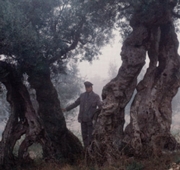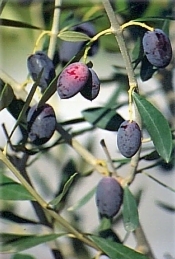

Genus: Olea
Species: europaea
Parts used: the fruit

The olive tree is the oldest known cultivated tree in history. Olives were first cultivated in Africa, and then spread to Morocco, Algiers, and Tunisia by the Phoenicians. Olea europaea was first cultivated in Crete and Syria over 5000 years ago. Around 600 BC olive tree cultivation spread to Greece, Italy and other Mediterranean countries.
The olive tree played a huge role in the civilization of the Mediterranean countries. Athens was named after the goddess Athena who brought the olive tree to the city. Historically it played a very important role in areas such as religion, diet, and art. It is also known as the symbol for peace, wisdom and victory. In the early Olympic games the winners were crowned with wreaths made of olive branches. Holy people were anointed with olive oil, and Moses exempted men who would grow olives from military service.
It isn't accurately known what the botanical ancestor of the modern olive tree is, but it is believed to be Oleaster olea sylvestris, which still grows wild in North Africa, Portugal, Southern France, Italy and areas around the Black and Caspian Seas. Some think that it originated from a tree which covered much of the Sahara Desert before the glaciers.
Olea europaea needs just the right climate to grow, hot in the summer, a slight winter chill, and plenty of sun. The Mediterranean area and other placeswith Mediterranean climates, such as Texas, Arizona, and California are good places to grow olives.
Olive trees can grow in nutrient-poor, but well-drained soils. It needs full sun for fruit production, but also needs a slight winter chill for the fruit to set. Temperatures below 15°F will kill a young tree. In the Mediterranean the olive fruit fly and the Mediterranean fruit fly are it main pests.
The olive tree is an evergreen tree with gray-green leaves, and small white fragrant flowers in the spring which produce a lot of pollen. A young olive tree has smooth gray bark, but as it gets older it gets very gnarled. A mature tree can reach a height of 25 to 30 feet, and live for hundreds of years. Some have even lived to be a thousand years.

To be able to survive in a hot and dry climate, olive trees have small leaves with a protective coating and hairy undersides that slows transpiration. An olive tree tends to grow dense, thin branches. To produce more fruit, the tree is pruned heavily. Olives ripen through the autumn and into the winter. As the oil content increases, the olives change color from green to violet to nearly black. The green olives are harvested first. Olives can be hand picked, gathered with a special wooden rake-like tool, or brought down by hitting the branches with long poles. A net is laid down on the ground to catch the harvest.
Olives are brought to a mill as soon as they are picked to keep down oxidation and acidity. There the dirt and leaves are cleaned from the olives. A mill grinds or hammers the olives and pits into a paste. This paste is extruded onto plates that fit into the press. The press squeezes out the olive juice and oil, leaving behind a fibrous "pomace". The oil is separated from the juice using decanters or centrifugal separators. The oil is then bottled and sold.
2001
Bibliography:
"Olive Tree", http://www.gilboa.co.il/ol-tree.htm
"History of Olives", http://www.olivepit.com/History_Of_Olives.asp
Janet Jemmott, "Olives: Growing 'Olea Europaea' - Kithcen Gardener Magazine", http://www.taunton.com/kg/features/growing/olives/1.htm
"Olea europaea - mediterranean climate gardening throughout the world", http://www.support.net/Medit-Plants/plants/Olea.europaea.html
"Making Olive Oil", http://www.oliveoilsource.com/making_olive_oil.htm